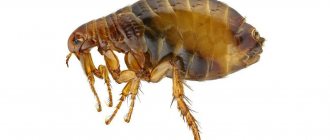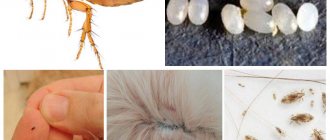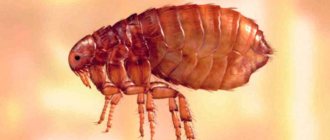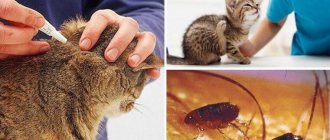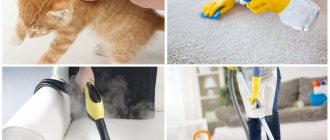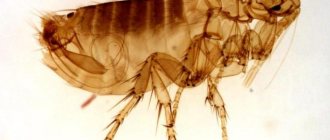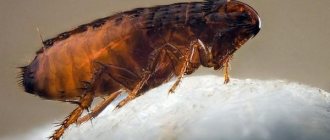The presence of fleas in a cat is not only an unnerving scratching of the pet for the owner, but a possible cause of a serious illness for the animal. Scratching from insect bites can lead to infection of the wounds with pathogenic microflora. In addition, the cat may experience an allergic reaction, accompanied by severe itching, swelling and fever.
Brief information: a flea is a wingless insect that parasitizes warm-blooded animals. The size of the insect is about 3 mm. The flea feeds on the blood of its owner, which it obtains by piercing the skin. It is a carrier of various infections.
Symptoms of infection
Fleas in cats cause characteristic symptoms that are simply impossible not to notice:
- frequent scratching, or more intense than usual licking of the fur;
- restless sleep;
- nervous behavior;
- loss of appetite.
In addition, on the undercoat of the animal you can see traces of insect activity - excrement resembling black grains of sand, and on the skin - scratches, wounds and scabs.
If the disease is not treated, it can lead to the following consequences:
- exhaustion of the animal from lack of sleep and nervous excitement;
- the appearance of bald spots on wool;
- development of anemia (decrease in hemoglobin level). Outwardly, this is manifested by the animal’s lethargy, weight loss, and pale gums. This condition requires treatment by a veterinarian;
- helminth infection;
- allergic dermatitis. This disease is characterized by the appearance of red spots on the skin of the cat's body, against which small blisters then appear. Subsequently, the bubbles burst (on their own or from scratching), and in their place weeping areas form. Over time, they dry out, scar, and scales and crusts form;
- secondary infection of wounds from scratching and, as a result, to inflammation, abscess and even sepsis.
A cat can get fleas even if it does not go outside on its own. Fleas can get on an animal when traveling on public transport, while participating in exhibitions and competitions. After visiting such places, you should examine your cat to prevent the breeding of “uninvited guests.”
Also, a likely source of fleas getting into the apartment and, accordingly, onto the cat is the owner of the animal himself. A flea can jump on a person’s shoes or clothes on the street or in a hallway, and thus get home.
If there are few fleas on a cat, then they may not be visible visually. You can check for the presence of parasites as follows:
- place the animal on a piece of white cloth (fleas, their excrement or eggs will be clearly visible on it);
- Take a special flea comb (with fine teeth) and gently comb the animal's fur from head to tail. Fleas and their metabolic products will either get stuck in the teeth of the comb or fall out onto the bedding fabric;
- You can distinguish dirt from excrement by placing unidentified black particles on a wet cloth. The excrement will change its color from black to brown or red as it contains the animal's blood.
Calling the Professionals for Flea Control
If you do not want to start a war with fleas, entrust the removal of uninvited guests from your apartment to mercenary exterminators. Their composure and extensive experience in this matter help to quickly defeat the enemy. The cost of professional flea disinfestation is higher than the cost of a can of insecticidal spray, but the specialist gives a guarantee and completes the work in the shortest possible time.
Call a specialist and tell them whether there are a lot of fleas in the apartment. This is important to choose the right drug and equipment.
Before the exterminator arrives, prepare the apartment for treatment.
- people and pets must leave the apartment during treatment;
- cover the aquarium with glass and turn off the air supply;
- remove bed linen and bedspreads, move furniture away from the walls;
- throw away old items that may contain flea colonies;
- hide food and dishes;
- prepare equipment for cleaning after disinfection.
What to do if you find a flea?
First of all, there is no need to panic. Parasitic insects are living organisms, which means they can be destroyed. For this purpose, special flea remedies for cats have been developed, which have been tested and successfully used in practice by millions of cat owners.
A brief algorithm of actions if you find parasites on your pet or in your apartment (house):
- if there are few fleas, or your kitten is still very small, then wash the animal with a special shampoo;
- If there are a large number of fleas, the shampoo may not be effective. In this situation, special drops should be used that will either kill the insects or make their offspring unviable. Read more about how to get rid of fleas from a cat in the next section of this article;
- After antiparasitic treatment, it is necessary to disinfest the room(s) where the cat lives. You can learn how to do this in the last section of this article;
- the next step is to eliminate the damage to the animal’s health caused by fleas. You can relieve your cat from itching and speed up the healing of wounds with the help of Miramistin solution. This pharmaceutical product disinfects wounds and has an anti-inflammatory effect; it can be purchased at a regular pharmacy. If you contact your veterinarian, he will prescribe an antihistamine. A visit to the doctor is also necessary if the wounds begin to rot.
Where do fleas come from in the house?
Fleas are very prolific: over 2 years of life, the female lays about 500 eggs, which after 2 weeks begin a full life and active reproduction. Insects need a source of food and a place to lay eggs. Therefore, they strive to penetrate the nest of a wild animal - a rabbit or a squirrel, or into a city apartment. How do they do this?
- a pet brings one or more insects from the street on its fur;
- flea eggs are carried into the apartment on the soles of shoes;
- fleas enter the apartment from neighbors;
- insects from the basement or attic can penetrate into nearby apartments
Flea drops
Parasite drops are the most effective remedy for ridding a cat of fleas. The drops repel or kill insects, destroy pathogenic microflora, and prevent re-infection. Drops are a concentrated solution of various insecticides that are harmful to fleas, but safe for cats.
The principle of action of the drops: the substance, when it gets on the animal’s skin, is absorbed and accumulates in the sebaceous glands. Then, over a long period of time, the substance is gradually released from the glands and repels the parasites, or affects their central nervous system, and they die. The effect on parasites occurs in the intestinal or contact way, i.e. the substance ends up in the stomach of the insect or gets on the surface of the body. After this, an irreversible reaction begins, leading to the death of the cat’s fleas.
Benefits of using drops:
- ease of use. Insect repellents are usually produced in the form of disposable pipettes. It is very convenient for application;
- duration of exposure. The drug should be used once every 2 to 3 months. The frequency of processing is different for each type of drop;
- universality of action. The drops protect the cat not only from fleas, but also from ticks and helminths.
Bonus for the cat owner: there will never be fleas in the room where an animal treated with insecticides lives. Parasites in the room move to the cat's body and then die.
Rules for treating cats for fleas:
- you need to break off the tip on the pipette along a specially made mark;
- then you should spread the fur on the animal’s withers with one hand, and with the other, squeeze a drop from the pipette onto the skin. This action must be repeated in several places in the area from the withers to the shoulder blades.
The amount of product applied depends on the age and weight of the pet. Dosage instructions are included with each type of drop. The drugs are sold without a prescription in veterinary pharmacies, clinics and pet stores.
Experts note that the most popular drops are Bravecto (USA), Stronghold (Zoetis), and Vectra Felice (France).
Important points:
- flea drops for cats can cause individual intolerance in the animal, so if an allergic reaction occurs, the cat should be washed immediately and then contact a veterinary clinic;
- You can treat your cat with flea drops no earlier than 2 days after bathing;
- after applying the drops, the animal cannot be washed for 2 days if the drug is water-based, and for 5 days if it is oil-based;
- on the first day after treatment, when the applied substance is most toxic, you should not pet the cat or allow it near children;
- Before removing fleas from cats, you must carefully read the instructions included with the drops.
Prevention
After you have treated your pet, you need to disinfect the room. Remember that fleas live in warm places, in crevices between the floor and the wall, and in high piles. Therefore, purchase wormwood extract or bleach at the pharmacy and treat the entire room, window sills (if they are wooden), furniture where there are cracks. Give a vacuum cleaner a good run through cracks and carpet piles, as well as upholstered furniture, to remove etched fleas and their eggs. An effective method would be to clean the room with dichlorvos.
The pet's bedding and clothing should be boiled or washed in hot water, and then ironed with plenty of steam. Put a collar on your pet or ask your veterinarian to prescribe a medication in drops that is used to prevent fleas.
Collar
Special repellent collars are saturated with an odor that fleas cannot tolerate, i.e. the product repels (but does not destroy insects). The collar is a porous tape, the material of which retains the smell of the substance applied to it well. This can be either a natural repellent - essential oil, which is safe for cats' health, or a small dose of a synthetic insecticide. For kittens and pregnant cats, collars with natural repellents should be used.
Experts recommend using collars as a preventative measure after the cat’s fleas have already been removed using more powerful insecticidal preparations, or used as a means of complex therapy (i.e. drops + collar). Repellent collars repel not only fleas, but also lice, scabies and ixodid ticks.
The effect of the flea collar lasts up to 8 months. It is very simple to use: just fasten the collar around the cat’s neck and trim off the excess. Do not remove it until the active substance wears off. There is a small “minus”: the fur under the collar cakes, and this is not suitable for cats that take part in exhibitions and competitions.
Collars popular with cat owners: “Bars” (AVZ), “Doctor Zoo”, “Bolfo” (Germany).
If a cat has scratches on its neck, you cannot use a collar; the active substance applied to it can get into the wound and cause a serious allergic reaction in the animal. You can put on a flea collar for cats only after the skin has completely healed.
How to choose the right product
The best insecticide is the one that will not only get rid of the infection, but also will not harm your pet. To choose the most effective one, we must not forget about several points:
- pet's age;
- health characteristics: allergies, intolerance to a component;
- physical state;
- specific properties of the drug;
- conditions of use: house or apartment;
- the presence of a child or elderly person in the house.
If you know exactly how, why and where to use a special tool, then choosing the right one will not be difficult. A veterinary pharmacy employee can give the correct recommendations. After purchasing a specific insecticide, you should carefully study the instructions. For prevention, collars or drops on the withers are best suited, which have a gentle effect on the cat itself, but do not lead to side effects.
For domestic cats that often walk outside, collars soaked in chemicals or natural essential oils are also suitable. You can remove them at home - then the skin will not be irritated. Animals that are taken to the country need to have drops applied to their withers.
How to safely remove fleas from a kitten? Offspring from 1 month of age are bathed with special medicinal compounds. For older children, drops are applied to the withers, and then collars are put on. In case of severe infection, they resort to the use of special aerosols.
Shampoo
Shampoo is the mildest remedy in the fight against blood-sucking insects. Special shampoo formulas have been developed that not only make pets' fur clean, but also destroy fleas.
Using shampoo, you can get rid of fleas even in pregnant cats, for whom the use of insecticides contained in flea drops is contraindicated.
Benefits of using shampoo for fleas in cats:
- affordable price;
- ease of use;
- low toxicity;
- Possibility of use for washing cats that are allergic to insecticides.
Shampoo can be dry, which must be used without water, or regular, which must be washed off the animal’s fur. Particular attention should be paid to rinsing the fur; this must be done very carefully, because cats, no matter how well they are wiped, will still lick themselves.
When choosing a detergent, you should pay attention to what breeds of cats the flea shampoo is intended for: long-haired, short-haired or hairless. It should also be clarified at what age this remedy can be used. The fact is that shampoo for small kittens and pregnant cats contains a minimal amount of toxic ingredients, and in the product for washing adult animals their concentration is much higher.
Experts recommend the following types of shampoos: “BIO-GROOM” (USA), “Bars” (AVZ), “Fitoelita” (Veda).
Flea shampoos for cats consist of three main ingredients:
- components that create soap foam;
- substances that care for the animal's fur. These are decoctions of medicinal herbs, essential oils;
- insecticides. Both synthetic substances (phenothrin, decamethrin) and natural ones (penitrin contained in Caucasian and Persian chamomile) are used.
Effective flea control
One of the most popular remedies against fleas and other blood-sucking insects in cats is drops called “Bars”, which combines a very reasonable price and high quality. These drops can be used on kittens from 2.5 months and adult cats. Watch the dosage! This is very important due to the increased sensitivity of cats to permethrin, which is the active ingredient of the drug. A single use of Barsa relieves the animal of fleas and ticks for a period of one to two months.
How to remove fleas from a cat at home?
You can remove fleas from a cat at home yourself, or by visiting a veterinary clinic. At the clinic, the doctor will examine the animal, determine the severity of the lesion, evaluate the individual clinical situation and select the appropriate method for removing insects.
Diagnosing the presence of fleas is not difficult for an ordinary person who is far from veterinary medicine. Therefore, the sooner treatment begins, the more effective it will be. Parasites are very prolific, so postponing treatment “for later” is unacceptable.
Are cat fleas dangerous for humans?
Cat fleas do not live on people, but they can bite them and thereby transmit the causative agents of some serious diseases.
Among the most dangerous diseases that cause fleas in domestic cats are:
- hepatitis - inflammatory damage to the liver;
- brucellosis – damage to many body systems: cardiovascular, respiratory, digestive, musculoskeletal, nervous, etc.;
- encephalitis - inflammation of the brain substance;
- helminths – worms that parasitize the body of animals and humans;
- Plague is a fatal disease (without treatment it ends in death). It is extremely rare in Russia; the last case was recorded in 2016 in Altai. Those cat owners who export their pets to Central Asia, Africa, and America should be concerned. It is especially important for them to know how to get rid of fleas from a cat as quickly and efficiently as possible.
The most common consequences of a flea bite for humans are allergic reactions, manifested in the form of severe itching and redness. It is also possible for infection to occur in scratched bite areas. This can already lead to a more serious outcome - purulent inflammation of the skin and penetration of infection into the bloodstream. This development of events is fraught with many dangerous diseases, including sepsis (blood poisoning).
Therefore, flea control is necessary not only to protect the cat from parasitic insects, but also to preserve human health.
